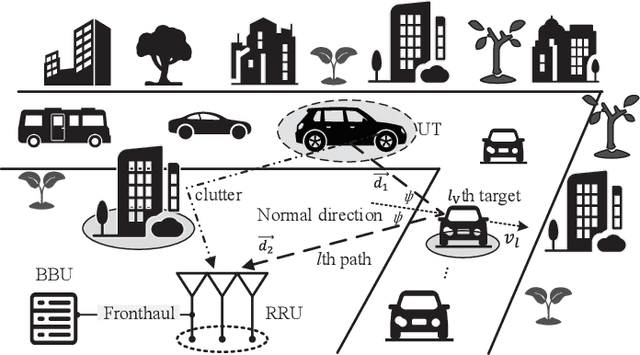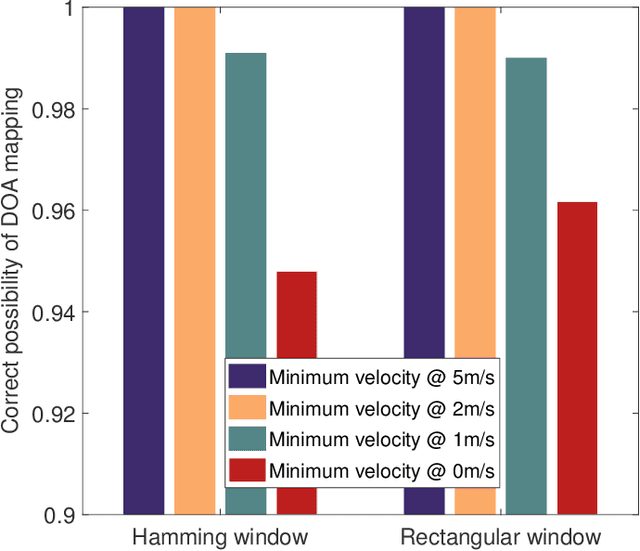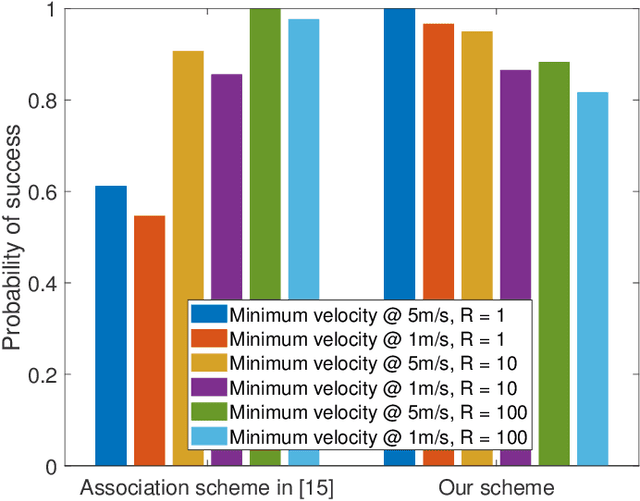Xiao-Yang Wang
Cross-Link Interference Mitigation With Over-the-Air Pilot Forwarding for Dynamic TDD
May 11, 2025Abstract:Dynamic time-division duplex (D-TDD) aided mobile communication systems bear the potential to achieve significantly higher spectral efficiency than traditional static TDD based systems. However, strong cross-link interference (CLI) may be caused by different transmission directions between adjacent cells in D-TDD systems, thus degrading the performance. Most existing CLI mitigation schemes require sharing certain information among base stations (BSs) via backhaul links. This strategy is usually expensive and suffers high latency. Alternatively, we propose a pilot information sharing scheme based on over-the-air forwarding of the downlink pilot of the interfering BS to the interfered BS via a wireless terminal, along with a dedicated CLI channel estimation method. Simulation results demonstrate that thanks to the proposed pilot information sharing scheme the classic interference rejection combining (IRC) receiver achieves a signal detection performance highly comparable to that of the IRC detector with perfect pilot information, necessitating no information sharing among BSs via backhaul links. Furthermore, the proposed CLI channel estimation scheme reduces the impact of errors introduced by pilot forwarding, thereby improving the performance of both CLI channel estimation and signal detection.
Network-Level ISAC Design: State-of-the-Art, Challenges, and Opportunities
May 02, 2025



Abstract:The ultimate goal of integrated sensing and communication (ISAC) deployment is to provide coordinated sensing and communication services at an unprecedented scale. This paper presents a comprehensive overview of network-level ISAC systems, an emerging paradigm that significantly extends the capabilities of link-level ISAC through distributed cooperation. We first examine recent advancements in network-level ISAC architectures, emphasizing various cooperation schemes and distributed system designs. The sensing and communication (S\&C) performance is analyzed with respect to interference management and cooperative S\&C, offering new insights into the design principles necessary for large-scale networked ISAC deployments. In addition, distributed signaling strategies across different levels of cooperation are reviewed, focusing on key performance metrics such as sensing accuracy and communication quality-of-service (QoS). Next, we explore the key challenges for practical deployment where the critical role of synchronization is also discussed, highlighting advanced over-the-air synchronization techniques specifically tailored for bi-static and distributed ISAC systems. Finally, open challenges and future research directions in network-level ISAC design are identified. The findings and discussions aim to serve as a foundational guideline for advancing scalable, high-performance, and resilient distributed ISAC systems in next-generation wireless networks.
Optimizing Fingerprint-Spectrum-Based Synchronization in Integrated Sensing and Communications
Oct 14, 2024



Abstract:Asynchronous radio transceivers often lead to significant range and velocity ambiguity, posing challenges for precise positioning and velocity estimation in passive-sensing perceptive mobile networks (PMNs). To address this issue, carrier frequency offset (CFO) and time offset (TO) synchronization algorithms have been studied in the literature. However, their performance can be significantly affected by the specific choice of the utilized window functions. Hence, we set out to find superior window functions capable of improving the performance of CFO and TO estimation algorithms. We first derive a near-optimal window, and the theoretical synchronization mean square error (MSE) when utilizing this window. However, since this window is not practically achievable, we then develop a practical window selection criterion and test a special window generated by the super-resolution algorithm. Numerical simulation has verified our analysis.
Clutter Suppression, Time-Frequency Synchronization, and Sensing Parameter Association in Asynchronous Perceptive Vehicular Networks
Sep 02, 2024



Abstract:Significant challenges remain for realizing precise positioning and velocity estimation in perceptive vehicular networks (PVN) enabled by the emerging integrated sensing and communication technology. First, complicated wireless propagation environment generates undesired clutter, which degrades the vehicular sensing performance and increases the computational complexity. Second, in practical PVN, multiple types of parameters individually estimated are not well associated with specific vehicles, which may cause error propagation in multiple-vehicle positioning. Third, radio transceivers in a PVN are naturally asynchronous, which causes strong range and velocity ambiguity. To overcome these challenges, 1) we introduce a moving target indication based joint clutter suppression and sensing algorithm, and analyze its clutter-suppression performance and the Cramer-Rao lower bound of the paired range-velocity estimation upon using the proposed clutter suppression algorithm; 2) we design algorithms for associating individual direction-of-arrival estimates with the paired range-velocity estimates based on "domain transformation"; 3) we propose the first viable carrier frequency offset (CFO) and time offset (TO) estimation algorithm that supports passive vehicular sensing in non-line-of-sight environments. This algorithm treats the delay-Doppler spectrum of the signals reflected by static objects as an environment-specific "fingerprint spectrum", which is shown to exhibit a circular shift property upon changing the CFO and/or TO. Then, the CFO and TO are efficiently estimated by acquiring the number of circular shifts, and we also analyse the mean squared error performance of the proposed time-frequency synchronization algorithm. Simulation results demonstrate the performance advantages of our algorithms under diverse configurations, while corroborating the theoretical analysis.
Windowing Optimization for Fingerprint-Spectrum-Based Passive Sensing in Perceptive Mobile Networks
Sep 02, 2024Abstract:Perceptive mobile networks (PMN) have been widely recognized as a pivotal pillar for the sixth generation (6G) mobile communication systems. However, the asynchronicity between transmitters and receivers results in velocity and range ambiguity, which seriously degrades the sensing performance. To mitigate the ambiguity, carrier frequency offset (CFO) and time offset (TO) synchronizations have been studied in the literature. However, their performance can be significantly affected by the specific choice of the window functions harnessed. Hence, we set out to find superior window functions capable of improving the performance of CFO and TO estimation algorithms. We firstly derive a near-optimal window, and the theoretical synchronization mean square error (MSE) when utilizing this window. However, since this window is not practically achievable, we then test a practical "window function" by utilizing the multiple signal classification (MUSIC) algorithm, which may lead to excellent synchronization performance.
On the Fundamental Trade-Offs of Time-Frequency Resource Distribution in OFDMA ISAC
Jul 17, 2024Abstract:Integrated sensing and communications (ISAC) is widely recognized as a pivotal and emerging technology for the next-generation mobile communication systems. However, how to optimize the time-frequency domain radio resource distribution for both communications and sensing, especially in scenarios where conflicting priorities emerge, becomes a crucial and challenging issue. In response to this problem, we first formulate the theoretical relationship between frequency domain subcarrier distribution and the range Cram\'er-Rao bound (CRB), and time domain sensing symbol distribution and the velocity CRB, as well as between subcarrier distribution and achievable communication rates in narrowband systems. Based on the derived range and velocity CRB expressions, the subcarrier and sensing symbol distribution schemes with the optimal and the worst sensing performance are respectively identified under both single-user equipment (single-UE) and multi-UE orthogonal frequency-division multiple access (OFDMA) ISAC systems. Furthermore, it is demonstrated that the impact of subcarrier distribution on achievable communication rates in synchronous narrowband OFDMA ISAC systems is marginal. This insight reveals that the constraints associated with subcarrier distribution optimization for achievable rates can be released. To substantiate our analysis, we present simulation results that demonstrate the performance advantages of the proposed distribution schemes.
Joint Sparsity Pattern Learning Based Channel Estimation for Massive MIMO-OTFS Systems
Mar 06, 2024Abstract:We propose a channel estimation scheme based on joint sparsity pattern learning (JSPL) for massive multi-input multi-output (MIMO) orthogonal time-frequency-space (OTFS) modulation aided systems. By exploiting the potential joint sparsity of the delay-Doppler-angle (DDA) domain channel, the channel estimation problem is transformed into a sparse recovery problem. To solve it, we first apply the spike and slab prior model to iteratively estimate the support set of the channel matrix, and a higher-accuracy parameter update rule relying on the identified support set is introduced into the iteration. Then the specific values of the channel elements corresponding to the support set are estimated by the orthogonal matching pursuit (OMP) method. Both our simulation results and analysis demonstrate that the proposed JSPL channel estimation scheme achieves an improved performance over the representative state-of-the-art baseline schemes, despite its reduced pilot overhead.
High-Performance Low-Complexity Hierarchical Frequency Synchronization for Distributed Massive MIMO-OFDMA Systems
Mar 30, 2023Abstract:We propose a high-performance yet low-complexity hierarchical frequency synchronization scheme for orthogonal frequency-division multiple-access (OFDMA) aided distributed massive multi-input multi-output (MIMO) systems, where multi-ple carrier frequency offsets (CFOs) have to be estimated in the uplink. To solve this multi-CFO estimation problem efficiently, we classify the active antenna units (AAUs) as the master and the slaves. Then, we split the scheme into two stages. During the first stage the distributed slave AAUs are synchronized with the master AAU, while the user equipment (UE) is synchronized with the closest slave AAU during the second stage. The mean square error (MSE) performance of our scheme is better than that of the representative state-of-the-art baseline schemes, while its computational complexity is substantially lower.
 Add to Chrome
Add to Chrome Add to Firefox
Add to Firefox Add to Edge
Add to Edge